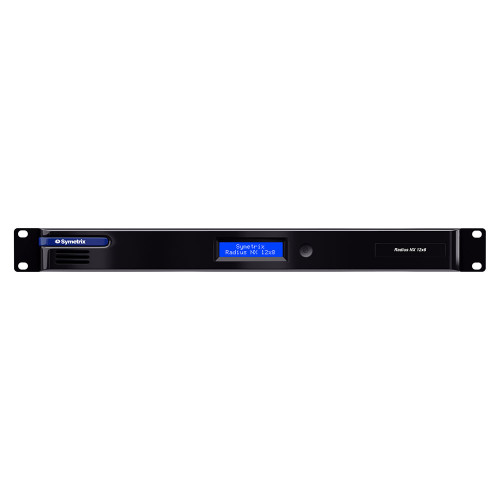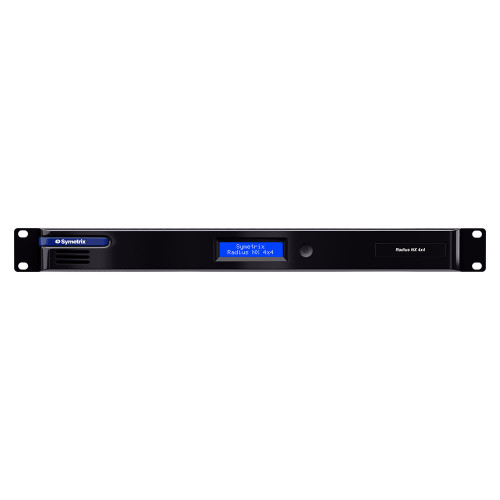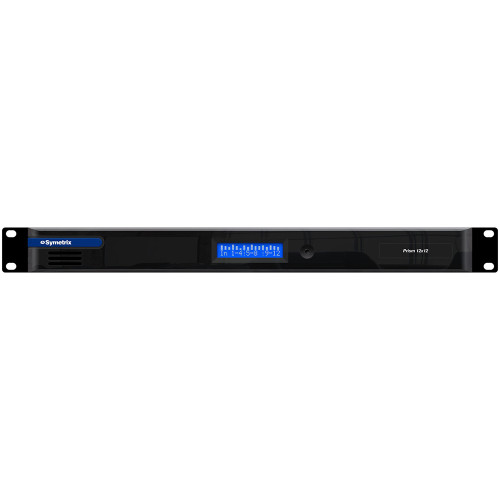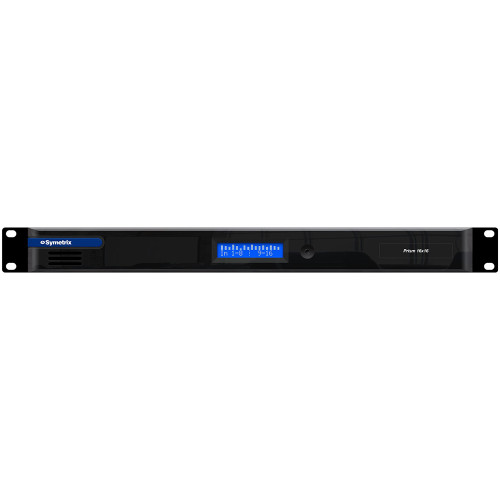Overview
Two models. Radius NX 4×4 (4 analog inputs, 4 analog outputs) and Radius NX 12×8 (12 analog inputs, 8 analog outputs). Both feature 64×64 redundant Dante and identical DSP resources. The two differ only in analog I/O, logic output, and external control input capacity. The reduced cost of the 4×4 makes it extremely competitive in applications where many Dante endpoints are routed to a primary DSP and fewer analog connections are required.
Optional virtualized and scalable AEC coprocessor module. For conferencing applications the dual-core coprocessor provides up to 16 channels of full bandwidth AEC with unparalleled clarity and intelligibility.
USB audio port. Enables soft-codec conferencing and computer-based multitrack recording or playback.
USB host port. Supports upcoming recording and archiving, audio media playback, digital messaging, and automatic unit backup for rapid field swaps.
128×128 Super Matrix. A Next-generation SHARC Dual-core Processor enables a Composer Super Matrix – placing the burden of large matrices in one core while freeing the second core for general purpose signal processing – making it possible to design very large and complex systems around a single Radius NX. View modes make navigating through large matrices a breeze.
Configurable 4-port gigabit switch. Services both Dante and control networks, eliminating or reducing the need for external switches while avoiding 100 Mbit bottlenecks.
Ultra-low noise preamps. Digitally controlled 3 dB steps facilitate precise gain setting resulting in unmatched sound quality.
Option card slot. Accepts all Radius and Edge Expansion Cards, maximizing Radius NX input/output counts or adding special purpose functionality to reduce total system cost.
Features
- Optional AEC coprocessor module – up to 16 channels.
- USB audio port enables soft-codecs + record/playback.
- Dedicated routing resources for a 128×128 Super Matrix.
- 4-port Gigabit Switch serves Dante + control networks.
- Ultra-low noise preamps with 3 dB gain steps.
- Support for Radius and Edge Expansion Cards.
Specifications
General Specifications
| Processor | 1 x Analog Devices Griffin ADSP-SC587 dual- core DSP @ 500 MHz |
| Raw processing capacity | 500 MIPS, 6 GFLOPS, 2 GMACS |
| Sampling rate | 48 kHz, ± 100 ppm. |
| Frequency response (A/D/A) | 20 Hz – 20 kHz, ± 0.5 dB. |
| Dynamic range (A/D/A) | > 114 dB, A-weighted. |
| Channel separation (A/D/A) | > 110 dB @ 1 kHz, +24 dBu |
| Latency (A/D/A) | 1.04 ms, inputs routed to outputs |
| Delay memory | 174 mono seconds. |
| Analog control inputs | 0-3.3 VDC. |
| Recommended external control potentiometer | 10k Ohm, linear. |
| Logic outputs | Low (0V) when active, pulled high (5V) when inactive. |
| Logic output maximum external power supply voltage / current sinking | 24 VDC / 50 mA. |
| Logic output maximum output current | 10 mA. |
| THD + Noise | < -95 dB (22.4 kHz BW, unweighted); 1 kHz @ +15 dBu with 0 dB gain |
| RS-232 accessory serial I/O | 57.6 kbaud (default), 8 data bits, 1 stop bit, no parity, no flow control wired straight-through, only pins 2, 3, and 5 required |
| RS-485 serial I/O | 38.4 kbaud (default) 8 data bits, 1 stop bit, no parity, no flow control. May be broken out of ARC port |
| Ethernet Cable | Standard CAT5/6, maximum device to device length = 328 feet / 100 meters |
| Dante Cable | Standard CAT6, maximum device to device length = 328 feet / 100 meters |
| ARC Cable | Standard CAT5/6, distance dependent upon load and number of devices |
| Maximum stored presets | 1000. |
Analog Inputs
| Connectors | 3.81 mm terminal blocks. |
| Number of inputs | Twelve (12) switchable balanced mic or line level |
| Nominal input level | +4 dBu |
| Maximum input level | +24 dBu |
| Mic Pre-amp Gain | 0 to 51 dB in 3 dB steps with ± 24 dB digital trim |
| Mic Pre-amp EIN | < -125 dB with 150 Ohm source impedance, 22.4 kHz BW |
| CMRR | > 50 dB @ 1 kHz, unity gain |
| Input impedance | 2k Ohms balanced, 1k Ohms unbalanced |
| Phantom Power (Per Input) | +48 VDC @ 10 mA maximum. |
| Dynamic range | > 115 dB, A-weighted. |
| THD + Noise | < -100 dB (22.4 kHz BW, unweighted); 1 kHz @ +15 dBu with 0 dB gain. |
| Latency | 0.31 mS |
Analog Outputs
| Connectors | 3.81 mm terminal blocks. |
| Number of outputs | Eight (8) balanced line level. |
| Nominal output level | +4 dBu with 20 dB of headroom. |
| Maximum output level | +24 dBu (+22.8 dBu into a 2 k Ohm minimum load). |
| Output impedance | 300 Ohms balanced, 150 Ohms unbalanced. |
| Dynamic range | > 117 dB, A-weighted. |
| THD + Noise | < -97 dB (22.4 kHz BW, unweighted); 1 kHz, 0 dB gain +8 dBu output |
| Latency | 0.65 mS. |
USB Audio I/O
| Connector | One (1) high-retention Type B |
| Interface | 2.0 with Audio class 1.0 legacy modes |
| Capacity | 1x1 (echo cancelling speakerphone and non-echo cancelling speakerphone modes) - driverless, 2x2 line I/O mode - driverless, and 8x8 line I/O mode - driver included |
| Sample Rate | 48 kHz |
| Bit Depth | 16-bit, speakerphone modes; 16 or 24-bit, line modes |
Mechanical Data
| Space Required | 1U (WDH: 18.91 in. x 9.5 in. x 1.72 in. / 48.02 cm x 24.13 cm x 4.37 cm). Depth does not include connector allowance. Allow at least 3 inches additional clearance for rear panel connections. Additional depth may be required depending upon your specific wiring and connections. |
| Electrical | 100-240 VAC, 50/60 Hz, 60 Watts maximum, universal input. |
| Ventilation | Maximum recommended ambient operating temperature is 30 C / 86 F. Ensure that the left and right equipment sides are unobstructed (5.08 cm, 2 in. minimum clearance). The ventilation should not be impeded by covering the ventilation openings with items such as newspapers, tablecloths, curtains, etc. |
| Shipping Weight | 13 lbs. (5.9 kg). |
| Certifications or Compliance | Safety: UL 60065, cUL 60065, IEC 60065 EMC: EN 55103-1, EN 55103-2, EN55032, EN 61000-3-2, EN 61000-3-3, ICES-003, FCC Part 15 (all Class A) Environmental: RoHS |
Architect & Engineer Specifications : Symetrix Radius NX 12×8
The device shall provide twelve analog mic/line inputs that are adjustable from line to mic level with coarse gain, fine trim, phantom power, invert and mute, and 8 analog line outputs that are adjustable with fine gain and mute. All signal processing, mixing and routing functions (including I/O levels) shall be controllable via software. Audio inputs and outputs shall be accessed via rear panel 3.81 mm terminal block connectors. An option card slot may accommodate either a 2 line VoIP interface card, 2 line analog telephone interface card, 4 channel digital input card, 4 channel digital output card, 4 channel mic/line input card, 4 channel AEC input card, 4 channel analog output card, 8×8 USB audio I/O card, or remain empty. An internal DSP coprocessor module may be installed for additional application-specific processing such as acoustic echo cancellation (AEC). A USB 2.0 audio I/O port with class 1.0 legacy modes on a high-retention Type B connection is configurable for up to 8×8 line I/O as well as 2×2 line I/O, 1×1 speakerphone, or 1×1 echo- cancelling speakerphone profiles. Network audio expansion shall be provided by the Dante protocol with a capacity of 128 (64×64) channels. Primary and Secondary Dante network audio connections shall be provided for redundant network implementation. Connectors shall be 1000 Base-T RJ45 utilizing CAT6 cable. A designer software application shall be provided that operates on a Windows computer, with network interface installed, running Windows 7® or higher operating system. Computer connection for configuration shall be via the device’s rear panel Ethernet connector. All internal processing shall be digital (DSP). Available DSP components shall include (but not be limited to) various forms of: mixers, equalizers, filters, crossovers, dynamics/gain controls, routers, delays, remote controls, meters, generators, onboard logic, and diagnostics. The front panel shall include a display and a momentary switch. The display shall provide communications and system status, I/O metering, and fault messages. External control shall include dedicated software screens as well as preset selection, I/O level control and muting using the optional ARC wall panel remote controls via industry-standard CAT5 cable with RJ45 connectors. A built-in web server shall provide four instances of ARC-WEB, which allows for user control from nearly any web browser or mobile device. Logic I/O shall consist of eight contact closures or four potentiometer inputs along with eight logic outputs. The logic outputs may be used to drive LEDs directly or control external relays or switchers. All program memory shall be non-volatile and provide program security should power fail. The device shall provide an on board real time clock to facilitate automatic, timed changing of presets and may sync to NTP. Third-party control systems may interface over IP and RS-232 using a published ASCII control protocol. Audio conversion shall be 24-bit, 48 kHz and internal processing shall be 32-bit or 40-bit floating point, 48 kHz. The dynamic range shall not be lower than 115 dB, A-weighted with a maximum input level of +24 dBu and maximum output level of +24 dBu. The device shall have an IEC power input socket for 120-240 VAC. The device shall meet UL/ CSA and CE safety requirements and comply with CE and FCC Part 15 emissions limits. The device shall be RoHS compliant. The chassis shall be constructed of Galvalume and molded plastic, and mount into a standard 19” 1U EIA rack using detachable rack ears. The device shall be a Symetrix Radius NX 12×8.













